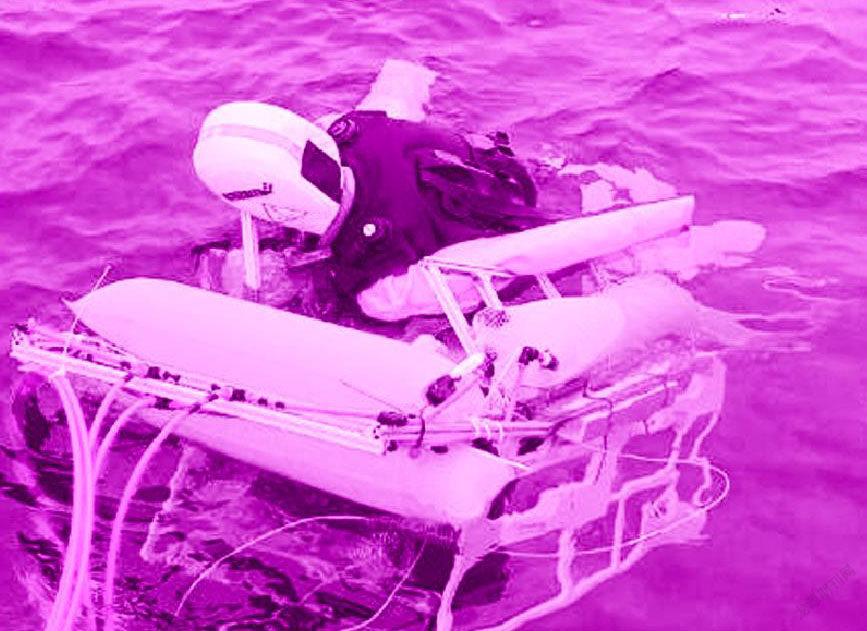防溺水机器人
李蓉蓉

德国的许多游泳池没有足够的训练有素的救生员,因此,许多游泳馆不得不关闭。针对这一问题,研究人员在水上救援服务的帮助下,开发了一款水下自主航行器,它可以用来拯救溺水者。
1Because of a lack of trained lifeguards to watch over swimming pools, a team ofscientists from Germany has developed an underwater robot, intending to assist life⁃guards in rescuing swimmers in emergencies.
2According to scientists, there are some typical postures that you can use to recognizewhen someone is in danger. The robot has been tested in a variety of settings including in⁃door pools and open water. If swimmers movements are consistent with drowning, the infor⁃mation of the drowning person will be sent out, which is stored in a docking station on thepool floor, and it will be released by a signal from the monitoring cameras. Once the robotreceives the signal and reaches its destination, it will carry the endangered person to thesurface. What‘s more, the robot is designed with a mechanism to keep the lifeless personfrom sliding down as the robot surfaces.
3When the robot is tested at lakes andother outdoor settings, drones took on the taskof the monitoring cameras. For rescues inswimming lakes where the visibility is re?stricted, the underwater vehicle must beequipped with acoustic sensors (声传感器).Sound wave echoes can be used to determinepeoples positions so precisely that the robot can autonomously head for the target person and pick them up. When the robot is informed of an emergency, a signal will alert the team immediately.
4The current system is 90 centimeters long, 50 centimeters high, and 50 centimeterswide and looks like an underwater submersible that might be used for exploring ship⁃wrecks. The central innovation of the system is the side folding wings that fix lifelesspeople on a stretcher without injuring them. To bring them to the surface of the water, bal⁃loons are filled with a total of 15 to 20 kilos of buoyancy (浮力).
5The research team are still doing research on the robot, aiming to make future ver⁃sions smaller, lighter and less expensive. At present, a patent has already been filed for theaquatic robot. In modified versions, it can take on further tasks—such as offshore and damwall inspections or being used to monitor the health of fish in fish farms.
Reading Check
Detail
1. Why did German researchers invent an underwater robot?
A. To prevent swimmers practising.
B. To assist lifeguards to rescue.
C. To check if there are emergencies.
D. To watch over the swimming pools.
Gist
2. What does paragraph 2 mainly talk about?
A. The mechanism that the robot has.
B. The procedures of the robots rescue.
C. Different typical postures of drowners.
D. The great success of the underwater robot.
Detail
3. How can the robot locate drowning people?
A. Through the special drones.
B. Through the docking station.
C. Through the sound sensors.
D. Through the monitoring cameras.
Detail
4. What can we know about the robot according to the last paragraph?
A. It will get further improved.
B. It can help to build dam walls.
C. It will be widely used in each field.
D. It wont take long to receive a patent.
Language Study
Ⅰ. Difficult sentence in the text
Because of a lack of trained lifeguards to watch over swimming pools, a team of scien?tists from Germany has developed an underwater robot, intending to assist lifeguards in res⁃cuing swimmers in emergencies. 由于缺乏训练有素的救生员来看管游泳池,德国一组科学家研发了一种水下机器人,旨在帮助救生员在紧急情况下营救游泳者。
【点石成金】本句中,Because of a lack of trained lifeguards to watch over swimmingpools为介词短语作状语;intending to assist lifeguards in rescuing swimmers in emergen⁃cies为现在分词短语作伴随状语的结构,表示主动。
Ⅱ. Text⁃centered chunks
watch over 看管
in danger 处于危险中
a variety of 各种各样的
be consistent with 和……一致
be equipped with 配备……
be informed of 知道
take on further tasks承担进一步的任务

